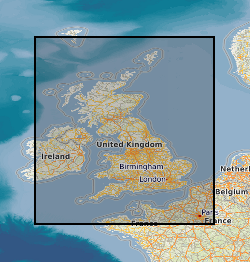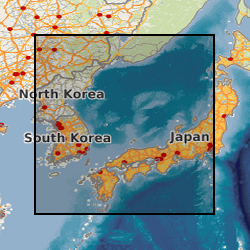Quaternary
Type of resources
Available actions
Topics
Keywords
Contact for the resource
Provided by
Years
Formats
Representation types
Update frequencies
Service types
Scale
Resolution
-
Quaternary QUEST was led by Dr Tim Lenton at UEA, with a team of 10 co-investigators at the Universities of Cambridge, Oxford, Reading, Leeds, Bristol, Southampton and at UEA. This dataset contains the Quaternary QUEST marine isotope data compilation for the last 150,000 years. The project team aimed to compile a synthesis of palaeodata from sediments and ice cores, improve the synchronization of these records with each other, and use this greater understanding of the Earth’s ancient atmosphere to improve Earth system models simulating climate over very long timescales. A combined long-term data synthesis and modelling approach has helped to constrain some key mechanisms responsible for glacial-interglacial CO2 change, and Quaternary QUEST have narrowed the field of ocean processes that could have caused glacial CO2 drawdown.
-
Quaternary QUEST was led by Dr Tim Lenton at UEA, with a team of 10 co-investigators at the Universities of Cambridge, Oxford, Reading, Leeds, Bristol, Southampton and at UEA. This dataset collection contains glacial and isotope model data. Over the last million years, the Earth has experienced a sequence of temperature oscillations between glacial and interglacial states, linked to variations in the Earth’s orbit around the sun. These climate oscillations were accompanied by changes in atmospheric CO2, but the fundamental reasons for this relationship are still unresolved. This project team aimed to compile a synthesis of palaeodata from sediments and ice cores, improve the synchronization of these records with each other, and use this greater understanding of the Earth’s ancient atmosphere to improve Earth system models simulating climate over very long timescales. A combined long-term data synthesis and modelling approach has helped to constrain some key mechanisms responsible for glacial-interglacial CO2 change, and Quaternary QUEST narrowed the field of ocean processes that could have caused glacial CO2 drawdown.
-
Quaternary QUEST was led by Dr Tim Lenton at UEA, with a team of 10 co-investigators at the Universities of Cambridge, Oxford, Reading, Leeds, Bristol, Southampton and at UEA. This dataset contains FAMOUS (FAst Met Office/UK Universities Simulator) glacial cycle model data from 150,000 years ago to present. The project team aimed to compile a synthesis of palaeodata from sediments and ice cores, improve the synchronization of these records with each other, and use this greater understanding of the Earth’s ancient atmosphere to improve Earth system models simulating climate over very long timescales. A combined long-term data synthesis and modelling approach has helped to constrain some key mechanisms responsible for glacial-interglacial CO2 change, and Quaternary QUEST have narrowed the field of ocean processes that could have caused glacial CO2 drawdown.
-

This Web service provides layers which are part of the BGS Superficial Deposits Thickness Model (SDTM) series of datasets. It currently includes two layers from the STDM 1 km hex grid dataset, which is available under the Open Government Licence. These two layers are symbolised on the mean and maximum values of the BSTM thickness model within the area of each hexagon. In these two layers, note that the data include a generic value of 1 m thickness for any area where superficial material is present, but is unproven by boreholes (shown on the map by a grey colour).
-

Digitally held Seabed Sediment, Facies, Bathymetry, Solid and Quaternary offshore geology for certain areas in the UK inshore waters. The storage formats of the data are ESRI and MapInfo but other formats can be supplied.
-

The dataset is the output of a NERC fellowship aimed to understand the long-term dynamics of tropical vegetation through palaeoecological analysis. For doing this, two sedimentary archives (Laguna Pindo and Laguna Baños) from Ecuador were radiocarbon dated and analysed for pollen, non-pollen palynomorphs, charcoal, chironomids, stable isotopes and XRF of tephra deposits. Each proxy was analysed at different resolution. Laguna Pindo is a mid-elevation lake (1250 m asl) that spans the last 50,000 years. Laguna Baños is an Andean lake located at 3800 m asl and contains sediments representative of the last 6500 years. Both water bodies are very shallow. The data is presented mainly in excel spreadsheets as raw data (except for radiocarbon dating data, which are the PDF files provided by NRCF), without any math treatment or conversion. Publication associated with NERC grant, Frazer Matthews-Bird, Stephen J. Brooks, Philip B. Holden, Encarni Montoya, and William D. Gosling (2016), Inferring late-Holocene climate in the Ecuadorian Andes using a chironomid-based temperature inference model. Clim. Past, 12, 1263-1280, 2016. doi:10.5194/cp-12-1263-2016
-

The Quaternary deposits thickness dataset is a digital geological map across the bulk of the UK Continental Shelf (UKCS), for areas up to a water depth of 200m, which shows the thickness of the deposits over bedrock in three categories: <5 m, 5 - 50 m, and >50 m Quaternary cover. These depth bands were picked because they represent the horizons that have impact on offshore infrastructure deployment. The map is derived from (unpublished) BGS 1:1000000 scale Quaternary digital geological mapping. The map was produced in 2014 in collaboration with, and co-funded by, The Crown Estate as part of a wider commissioned project to assess seabed geological constraints on engineering infrastructure across the UKCS. The data are held by the BGS as an ESRI Shapefile.
-

This dataset shows the variation of the thickness of superficial (Quaternary age) deposits across Great Britain. The data are presented as a vector map of interlocking hexagon cells (side length 1 km, area c. 2.6 km2) covering the landmass of Great Britain as a regular grid. Each hexagon cell is attributed with statistics about the thickness of the underlying Quaternary units (average thickness and maximum thickness) for that cell. Additional information relating to the coverage of the underpinning data is also provided. The data are derived from the BGS Basic Superficial Thickness Model (BSTM). The data is all derived by spatially summarising the information within the BGS Basic Superficial Thickness Model (BSTM), which is a 50 m cell size raster model of superficial thickness, first published in 2010.
-

This award was made as a sailing participant of IODP Expedition 346, an international ocean drilling programme that NERC subscribe to. As such there was a lot of data generated that is owned and kept by IODP and which is freely available at: web.iodp.tamu.edu/UWQ/. Published Paper: Integrated Ocean Drilling Program Expedition 346 Scientific Prospectus - Asian Monsoon Onset and evolution of millennial-scale variability of Asian monsoon and its possible relation with Himalaya and Tibetan Plateau uplift. doi:10.2204/iodp.sp.346.2013
-

This dataset presents tephra layers, Ar-dates, age-model & stable isotope data from the >250 kyr-long Lake Chala sediment record, Kenya/Tanzania. The file is split into six tables: (1) metadata on the 30 tephra layers (29 visible tephra layers, one cryptotephra) studied to date, including sample and core codes, summary characteristics and ages; (2) summary of Ar-dating results on ten of the Lake Chala tephra layers; (3) the DCH_TephraAge Bayesian age model, which combines tephra, 210Pb and 14C age-estimates for the length of the core; (4) Raw single-grain WDS-EPMA results for all tephra layers studied in the DeepCHALLA sediment record; and (5) secondary standard data; (6) unpublished Diatom ?18O (‰ VSMOW), Bulk organic ?13C (‰), %C and Diatom d13C (‰) measurements for the full length of the core (given on a composite depth scale). These chronological data (Tables 1-5) are central to the reconstruction of palaeoclimate from a multi-proxy analyses of the Lake Chala sediment sequence and are included in publications by Baxter et al. (2023) and Martin-Jones et al. (2020, in review), for which references are given in the appropriate files. Stable isotope data (produced by Barker and Leng) remains unpublished at the time of upload. The data was generated by Catherine Martin-Jones, Christine Lane, Maarten Blaauw, Darren Mark, Melanie Leng and Phil Barker between 2017-2022. Much of the tephra data is published and references are provided.
 NERC Data Catalogue Service
NERC Data Catalogue Service